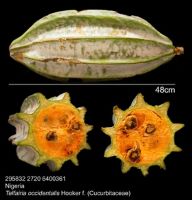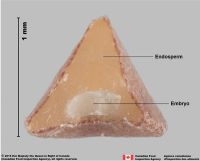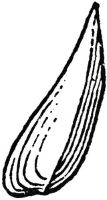Content is from Kirkbride et al. 2006Kirkbride et al. 2006:
Kirkbride JH, Jr, Gunn CR, and Dallwitz MJ. 2006. Family guide for fruits and seeds, vers. 1.0. Accessed September 2020-January 2022. URL: https://nt.ars-grin.gov/seedsfruits/keys/frsdfam/index.cfm ., without modification.
Updates are forthcoming.
Fruits: Pistil(s) compound, or simplesimple:
fruit formed from a single flower with one pistil, solitary carpel or several fused carpels
; 1; 1-pistillate; with carpels united. Fruit pericarpium; simplesimple:
fruit formed from a single flower with one pistil, solitary carpel or several fused carpels
, or schizocarpschizocarp:
usually dry fruit splitting between two or more locules to form distinct, indehiscent, usually one seeded segments; fruit derived from a single, superior or inferior, compound ovary; compare to mericarp ; drupedrupe:
; drupedrupe:
(indehiscent drupe) a fleshy, indehiscent fruit with one more hard pits enclosing seeds, derived from single, superior, simple or compound ovary; (dehiscent drupe) a fruit with a dry or fibrous to fleshy or leathery outer husk that early to tardily breaks apart (or opens), exposing one or more nutlike pits enclosing the seeds , or nuculanium; druparium; without persistent central column; with styles(s); sub at base or nearly basalbasal:
, or nuculanium; druparium; without persistent central column; with styles(s); sub at base or nearly basalbasal:
at or pertaining to the point of attachment; (of embryo) embryo occupies one end of the seed
; not within accessory organ(s); more than 1 but less than 10-seeded; 2(–3)-seeded; less than 1 cm long; 0.8 cm long; with 2(–3)-carpellate; with carpels united; with carpels remaining united at maturity; with carpels not radiating at maturity; with carpels separating at stylestyle:
in a flower, the narrow and elongated part of the pistil between the stigma and the ovary; sometimes persisting in fruit ; without sterilesterile:
; without sterilesterile:
lacking male and/or female reproductive parts; also, not producing fruit or seed
 carpels; not sulcatesulcate:
carpels; not sulcatesulcate:
surface relief—having one or more elongate, relatively narrow and shallow depressions or grooves ; apexapex:
; apexapex:
the point farthest from the point of attachment, or the "tip" of an organ beaked; apexapex:
beaked; apexapex:
the point farthest from the point of attachment, or the "tip" of an organ long beakedbeak:
long beakedbeak:
a usually firm, terminal appendage, sometimes tapered , or moderately beaked; indehiscentindehiscent:
, or moderately beaked; indehiscentindehiscent:
not opening on its own, as in a fruit
 . Epicarpepicarp:
. Epicarpepicarp:
outer layer of fruit wall or pericarp, if divided into layers; note here used synonymously with exocarp blue (bright); durable; glabrousglabrous:
blue (bright); durable; glabrousglabrous:
without hairs
; without armature; fresh smooth, or not smooth (upon drying); wrinkledwrinkled:
surface relief—shallow, irregular folds and furrows covering the surface; appearing overall though crumpled and then spread out ; without wing(s); without apicalapical:
; without wing(s); without apicalapical:
at or pertaining to the end of the seed or fruit distal from its point of attachment (i.e., base)
respiratory hole. Mesocarpmesocarp:
the middle layer of the pericarp, if divided into layers present; fleshyfleshy:
present; fleshyfleshy:
texture—fairly firm and dense, juicy or at least moist, and easily cut
; composed of 1 unified layer; without lactiform cavity system. Endocarpendocarp:
the inner layer of the pericarp, if divided into layers present; not separating from exocarpexocarp:
present; not separating from exocarpexocarp:
outer layer of fruit wall or pericarp, if divided into layers; note here used synonymously with epicarp ; bonybony:
; bonybony:
very hard and rather brittle, like bone
, or crustaceouscrustaceous:
texture—thin, dry, indurate, and brittle
; not splitting into 1-seeded pyrenes; stone unilocular; not smooth; with pits, or sculptures, or rugoserugose:
=wrinkled ; without wing; without operculumoperculum:
; without wing; without operculumoperculum:
a dehiscent cap (or lid) of a seed or fruit that opens during germination or dehiscence
 ; without secretory cavities; without mechanism for seedling escape; without grooves; without longitudinallongitudinal:
; without secretory cavities; without mechanism for seedling escape; without grooves; without longitudinallongitudinal:
of or relating to length or the lengthwise dimension
ridges. Funiculusfuniculus:
(alt. funicle) stalk connecting the ovule (later seed) to the ovary (later fruit) placenta short; short without seed bearing hooks (retinacula); not persisting in fruit after seed shed.
short; short without seed bearing hooks (retinacula); not persisting in fruit after seed shed.
Seeds: Arilaril:
(broad sense) appendicular structure that wholly or partly envelops a seed and is produced from or a modification of the funicle, raphe, or outer integument; usually fleshy or pulpy, sometimes spongy or tufted-capillate, often brightly colored absent. Seed in transectiontransection:
absent. Seed in transectiontransection:
a cross section; representing a plane made by cutting across an organ at a right angle to its length sub tereteterete:
sub tereteterete:
approximately circular in cross section; width and thickness approximately equal
 , or compressedcompressed:
, or compressedcompressed:
flattened; in grasses, used to denote compression (not necessarily flattened) either laterally or dorsiventrally
; not bowl shaped; not nutlike; without winglike beakbeak:
a usually firm, terminal appendage, sometimes tapered ; without caudatecaudate:
; without caudatecaudate:
tapering to a long, tail-like appendage appendage(s); at maturity with food reserves, or without food reserves, or without apparent food reserves; with endospermendosperm:
appendage(s); at maturity with food reserves, or without food reserves, or without apparent food reserves; with endospermendosperm:
nutritive starch- and oil-containing tissue present in many seeds ; without canavanine. Sarcotestasarcotesta:
; without canavanine. Sarcotestasarcotesta:
pulpy or fleshy outer layer of the seed coat, simulates aril absent. Testatesta:
absent. Testatesta:
seed coat
 present; without markedly different marginalmarginal:
present; without markedly different marginalmarginal:
at, on, or close to the margin or border
tissue; without fleshyfleshy:
texture—fairly firm and dense, juicy or at least moist, and easily cut
or leatheryleathery:
texture—moderately thick, tough, and very pliable
layer over hard layer; tight; without crease or line separating cotyledons from hypocotyl-radicle; without notch along margin where cotyledons from hypocotyl-radicle tip approach each other; without glands; without bristles; glabrousglabrous:
without hairs
; without wings; without collar; without operculumoperculum:
a dehiscent cap (or lid) of a seed or fruit that opens during germination or dehiscence
 ; colored; monochrome; membranousmembranous:
; colored; monochrome; membranousmembranous:
texture—extremely thin, pliable, and fairly tough
, or coriaceouscoriaceous:
texture—leathery
; not becoming mucilaginousmucilaginous:
resembling mucilage; moist and sticky
when wetted; surrounding embryo, or surrounding food reserve. Endospermendosperm:
nutritive starch- and oil-containing tissue present in many seeds development helobial; scant. Embryo differentiated from food reserve; well developed; 1 per seed; completely filling testatesta:
development helobial; scant. Embryo differentiated from food reserve; well developed; 1 per seed; completely filling testatesta:
seed coat
 (no food reserve), or nearly filling testatesta:
(no food reserve), or nearly filling testatesta:
seed coat
 (trace or scanty food reserve); 3 times the length of food reserve; at one end of seed not extending into a depression or cup; foliatefoliate:
(trace or scanty food reserve); 3 times the length of food reserve; at one end of seed not extending into a depression or cup; foliatefoliate:
appearing leaf-like
; flatly coiledcoiled:
(of embryo) linear embryo is very long and bent to form a coil whereby one end of the embryo is on the outside and the other end near the middle of the seed (circinate); with cotyledons abruptly connected to hypocotyl-radicle; without coleorhiza; without simmondsin; with cotyledons containing oils; without stomata; not green; with 2 or more cotyledons. Cotyledons 2; well developed; 0.2–0.5 times length of embryo; somewhat to significantly wider than hypocotyl-radicle; 3.6–5 times wider than hypocotyl-radicle; partially concealing hypocotyl-radicle; thickthick:
(circinate); with cotyledons abruptly connected to hypocotyl-radicle; without coleorhiza; without simmondsin; with cotyledons containing oils; without stomata; not green; with 2 or more cotyledons. Cotyledons 2; well developed; 0.2–0.5 times length of embryo; somewhat to significantly wider than hypocotyl-radicle; 3.6–5 times wider than hypocotyl-radicle; partially concealing hypocotyl-radicle; thickthick:
having or being of relatively great depth
, or thinthin:
having or being of relatively little depth
; twice-folded, or circinatecircinate:
3D shape—terete and rolled downward from the apex in a tight coil
; smooth, or rugoserugose:
=wrinkled ; with apicesapex:
; with apicesapex:
the point farthest from the point of attachment, or the "tip" of an organ entire; with margins separate; basally entire; equal in size; not punctatepunctate:
entire; with margins separate; basally entire; equal in size; not punctatepunctate:
surface relief—dotted with pits or with translucent, sunken glands or with colored dots, similar to pitted dotted. Hypocotyl-radicle well developed; curvedcurved:
dotted. Hypocotyl-radicle well developed; curvedcurved:
(of embryo) linear embryo is curved into an arch or horseshoe with the ends far apart (against cotyledons); not thickened.
(against cotyledons); not thickened.
 drupaceous carpels".
drupaceous carpels".
General references: Airy Shaw, H.K. 1973. A dictionary of the flowering plants and ferns, 1,131 pp. University Press, Cambridge, Cronquist, A. 1981. An integrated system of classification of flowering plants, 1,262 p. Columbia University Press, New York, Engler, A. & K. Prantl. 1924 and onward. Die Natürlichen Pflanzenfamilimien. W. Engelman, Leipzig, Goldberg, A. 1986 (dicots) & 1989 (monocots). Classification, evolution, and phylogeny of the familes of Dicotyledons. Smithsonian Contr. Bot. 58 for dicots (314 pp.) & 71 for monocots (74 pp.). [Goldberg's illustrations are reproduced from older publications and these should be consulted], Gunn, C.R., J.H. Wiersema, C.A. Ritchie, & J.H. Kirkbride, Jr. 1992 & amendments. Families and genera of Spermatophytes recognized by the Agricultural Research Service. Techn. Bull. U.S.D.A. 1796:1–500, Hooker, J.D. 1873 and forward. Icones Plantarum. William & Norgate, London. (plate number cited in text within [ ]), Mabberley, D.J. 1987. The plant-book, 706 p. Cambridge University Press, Cambridge, and Spjut, R.W. 1994. A systematic treatment of fruit types. Mem. New York Bot. Gard. 70:1–182.